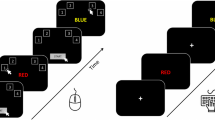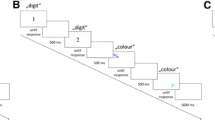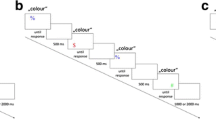Abstract
A core tenet of the original conflict-monitoring model is that regulation is triggered automatically when conflict is present and that the same regulation mechanism explains both trial-to-trial adaptation effects as well as effects of block-wise conflict manipulations. We present here results from two experiments using the Stroop task that show (a) that adaptation effects in the absence of response repetitions may occur only at the beginning of testing and that (b) robust block-wise effects can be found even in the absence of trial-by-trial effects. Furthermore, we show that the failure to eliminate target-to-distractor repetitions can produce artificial trial-to-trial adaptation effects. Based on the evidence of a weak link between conflict and conflict adaptation, we argue that a wider range of possible reasons for conflict adaptation effects needs to be taken into consideration.


Similar content being viewed by others
References
Awh, E., Sgarlata, A. M., & Kliestik, J. (2005). Resolving visual interference during covert spatial orienting: online attentional control through static records of prior visual experience. Journal of Experimental Psychology: General, 134(2), 192–206.
Botvinick, M. M., Braver, T. S., Barch, D. M., Carter, C. S., & Cohen, J. D. (2001). Conflict monitoring and cognitive control. Psychological Review, 108, 624–652.
Blais, C., Dobidoux, S., Risko, E. F., & Besner, D. (2007). Item-specific adaptation and the conflict-monitoring hypothesis: A computational model. Psychological Review, 114, 1076–1086.
Bryck, R.L., & Mayr, U. (in press). Task selection cost asymmetry without task switching. Psychological Bulletin and Review.
Cohen, J. D., Dunbar, K., & McClelland, J. L. (1990). On the control of automatic processes: A parallel distributed processing model of the Stroop effect. Psychological Review, 97, 332–361.
Egner, T., & Hirsch, J. (2005). The neural correlates and functional integration of cognitive control in a Stroop task. NeuroImage, 24, 539–547.
Fernandez-Duque, D., & Knight, M. B. (2007). Cognitive control: Dynamic, sustained, and voluntary influences. Journal of experimental psychology. Human perception and performance.
Freitas, A. L., Bahar, M., Yang, S., & Bahar, R. (2007). Contextual adjustments in cognitive control across tasks. Psychological Science, 18, 1040–1043.
Gilbert, S. J., & Shallice, T. (2002). Task switching: a PDP model. Cognitive Psychology, 44, 297–333.
Gratton, G., Coles, M. G. H., & Donchin, E. (1992). Optimizing the use of information: Strategic control of activation of responses. Journal of Experimental Psychology: General, 121, 480–506.
Jacoby, L. L., Lindsay, D. S., & Hessels, S. (2003). Item-specific control of automatic processes: Stroop process dissociations. Psychonomic Bulletin & Review, 10, 638–644.
Kenny, D. A. (1975). Cross-lagged panel correlation: A test for spuriousness. Psychological Bulletin, 82, 887–903.
Kerns, J. G., Cohen, J. D., MacDonald, A. W., I. I. I., Cho, R. Y., Stenger, V. A., & Carter, C. S. (2004). Anterior cingulate conflict monitoring and adjustments in control. Science, 303, 1023–1026.
Kunde, W. (2003). Sequential modulations of stimulus-response correspondence effects depend on awareness of response conflict. Psychonomic Bulletin and Review, 10, 198–205.
Logan, G. D. (1988). Toward an instance theory of automatization. Psychological Review, 95, 492–527.
May, C. P., Kane, H. J., & Hasher, L. (1995). Determinants of negative priming. Psychological Bulletin, 118, 35–54.
Mayr, U. (2004). Consciousness and control. Trends in Cognitive Science, 8, 145–148.
Mayr, U. (2007). Conflict and Control. Presentation at the Workshop “Conclicts as Signals” in Binz, Germany, October 2007.
Mayr, U., & Bryck, R. L. (2005). Sticky rules: Integration between abstract rules and specific actions. Journal of Experimental Psychology: Learning, Memory, and Cognition, 31, 337–350.
Mayr, U., & Bryck, R. L. (2006). Outsourcing control to the environment: effects of stimulus/response locations on task selection. Psychological Research, 71, 107–116.
Mayr, U., Awh, E., & Laurey, P. (2003). Conflict adaptation effects in the absence of executive control. Nature Neuroscience, 6, 450–452.
Nieuwenhuis, S., Stins, J. F., Posthuma, D., Polderman, T. J. C., Boomsma, D. I., & De Geus, E. J. (2006). Accounting for sequential trial effects in the flanker task: Conflict adaptation or associative priming? Memory & Cognition, 34, 1260–1272.
Schmidt, J. R., Crump, M. J., Cheesman, J., & Besner, D. (2007). Contingency learning without awareness: Evidence for implicit control. Consciousness and Cognition, 16, 421–435.
Shiffrin, R. M., & Schneider, W. (1977). Controlled and automatic human information processing: II. Perceptual learning, automatic attending, and a general theory. Psychological Review, 84, 127–190.
Tzelgov, J., Henik, A., & Berger, J. (1992). Controlling Stroop effects by manipulating expectations for color words. Memory & Cognition, 20, 727–735.
Ullsperger, M., Bylsma, L. M., & Botvinick, M. (2005). The conflict-adaptation effect: It’s not just priming. Cognitive, Affective and Behavioral Neuroscience, 5, 467–472.
Verbruggen, F., Notebaert, W., Liefooghe, B., & Vandierendonck, A. (2006). Stimulus and response conflict-induced cognitive control in the flanker task. Psychonomic Bulletin & Review, 13, 328–333.
Author information
Authors and Affiliations
Corresponding author
Rights and permissions
About this article
Cite this article
Mayr, U., Awh, E. The elusive link between conflict and conflict adaptation. Psychological Research 73, 794–802 (2009). https://doi.org/10.1007/s00426-008-0191-1
Received:
Accepted:
Published:
Issue Date:
DOI: https://doi.org/10.1007/s00426-008-0191-1




